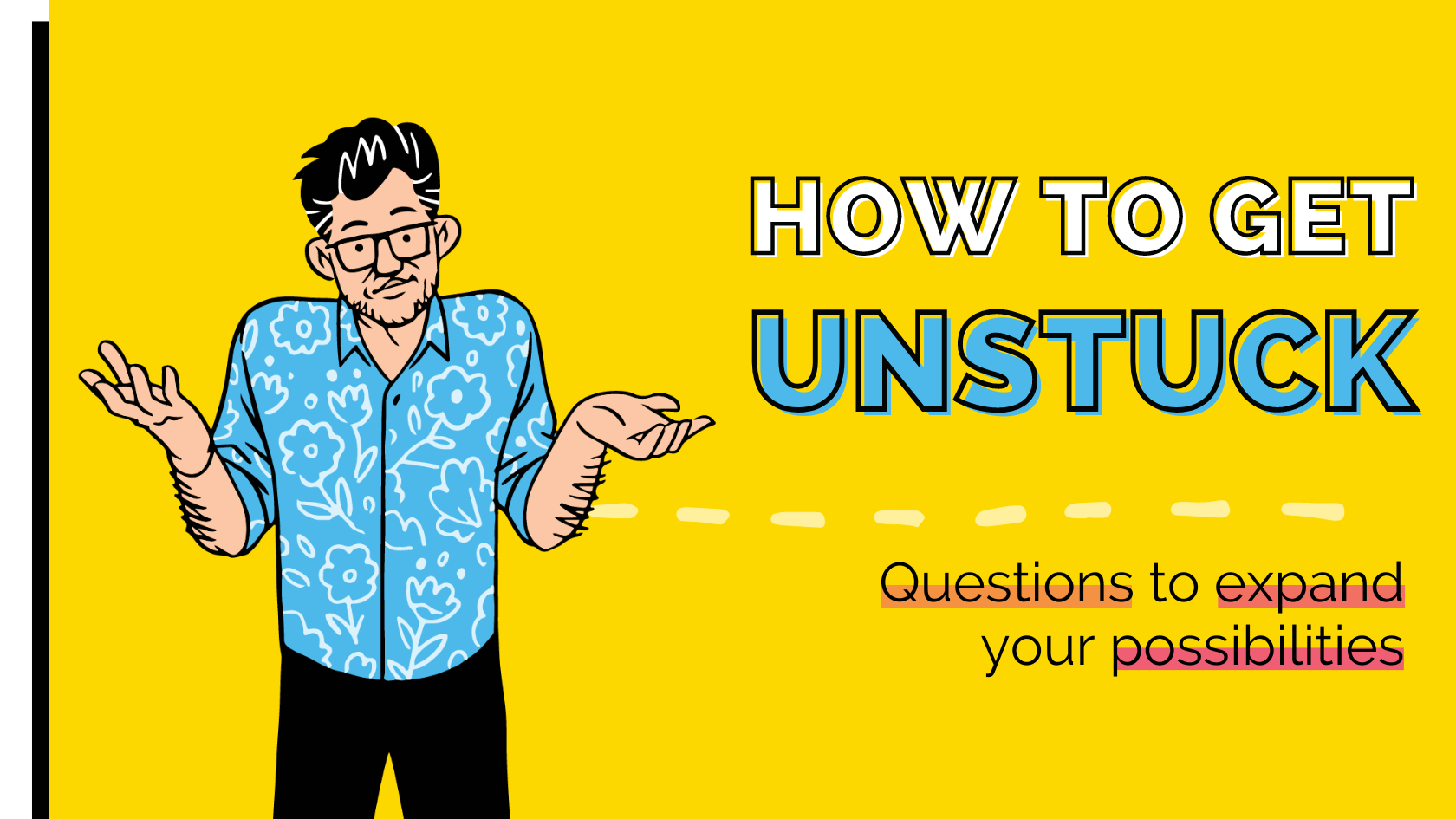While working for an innovation company, I got good at asking brainstorm-y questions to generate possibilities.
Now, if you’ve read absolutely anything I’ve written, you’ll know that I love a good question. Well, that early work experience planted that seed.
Learning how to ask good questions proved helpful in being part of the team that invented Loch Dhu for Diageo, a single malt whisky that was reviewed as one of the worst single malts ever made. (You’re welcome.)
It also proved helpful when I moved into the world of increasing personal impact through coaching techniques, self-growth, learning, questing, growing, evolving, and so on.
The principles are the same – and you can use them to get unstuck.
Where Do I Feel Stuck?
Stuck is often when you think you have just one way forward – and you don’t like that way.
Unstuck is when you can see other possibilities.
You know the stuck-iness feeling – spinning wheels that go nowhere. Mundane daily ruts. Hitting a plateau you can’t ascend past.
Where does that feeling come from? Well, here are three places to look:
- Projects. Has your project reached a dead end, and you can’t find a way to break through? Or maybe you’re turning in good work and it keeps you going, but you’re not pushing yourself to do more great work – work that has impact and meaning.
- People. Perhaps you’re going through the motions in a close relationship? It might be bad or not that bad, but certainly not as great as it could be. Or could you communicate better with someone who matters to you? Are you taking for granted their presence, their friendship, their generosity?
- Patterns. Is it a pattern of your own behavior? The days and weeks are passing in a familiar groove. Pleasant enough, perhaps, but where’s the zest? Is your routine responsible for playing it safe? Keeping you from breaking something precious? Or avoiding the hard thing?
You know what I’m talking about.
Find your stuck place. Once you’ve identified it, let’s see what we can do about it.
How to Get Unstuck? Ask Yourself These Questions
Here are my go-to questions to get unstuck. The invitation is to pick one and try it. Get a challenge in mind and ask away.
Note, reader, all of these questions benefit from asking “and what else?” after your first and subsequent answers, because your first answer is not your best or only idea.
1. What Can I Do?
“What can I do?” and then asking, “and what else?”, “and what else?”, “and what else?” is really powerful because, so often, we think of one or two things we can do and then we stop.
But this question challenges you to move beyond your old ideas, so you can have new ones. It’s kind of like tipping your head to the side and emptying out all the solutions you’ve already got out of your brain, creating more neural space and capacity to generate new and different ideas.
This question is also a great chance to practice not getting overly judgy about what you can do. We’re well-trained to have an idea, and then immediately come up with reasons why it’s not a good idea why we shouldn’t do it, or why it’s a bit silly, a bit stupid, or a bit impossible.
Instead, think of this question as a warm-up – an opportunity to get limber, think bigger, and get your ideas out of your head. In fact, I recommend setting yourself the task of coming up with twenty ideas in three minutes.
It sounds a lot, I know. But it’s only one idea every twelve seconds. So, squeeze out all your creative juices as a first step.
2. What Can I Stop Doing?
In his wonderful book, Subtract, Leidy Klots explains: “In our striving to improve our lives, our work, and our society, we overwhelmingly add. We overlook the option to subtract from what is already there.”
To encapsulate this, he performed a study, in which he asked participants to alter a Lego structure into a new shape. Each participant was told they’d earn a dollar for completing the task, but each Lego piece they added would cost an additional ten cents.
The simplest, most cost-effective solution to the challenge is to take blocks away, but most of the participants added more pieces.
Understanding this about human wiring is a powerful way to get unstuck. Look at your current to-do list and flip it on its head – change it to a “stop doing” list and subtract outdated ideas, things that no longer serve you, and meaningless work.
3. What’s the Fast Thing to Do?
Finding the fastest thing to do is about building momentum. When you feel stuck, focus solely on the next, small action you need to take rather than becoming overwhelmed by the gargantuan scope of the entire project. This idea has its roots in David Allen’s book, Getting Things Done.
So, say you’ve got to come up with a new concept at work, and you feel like you’re staring up a huge mountain that you have no idea how to climb.
The first step could be as simple as opening Google. Then, your next small step could be typing in a question, and your third to read an article for inspiration.
By breaking down the project into small steps, climbing the mountain will feel way less overwhelming and way more manageable, and before you know it you’ll have covered a great amount of ground.
4. What’s the Easiest Thing to Do?
“The reasonable man adapts himself to the world; the unreasonable one persists in trying to adapt the world to himself. Therefore, all progress depends on the unreasonable man.”
Invaluable pearls of wisdom by George Bernard Shaw.
While the reasonable man is likely to work hard, sweat it out, and try to make things happen, the unreasonable person says, “There’s got to be a better way of doing this. What’s the easiest way of making this happen?”
Discovering the easiest thing to do is a powerful way to de-complicate the task at hand. It’s about finding a solution that takes little effort but has maximum impact. In essence, it’s asking how can you be lazy while being more productive.
Quite often, the easiest thing to do is to actually stop doing something, so don’t forget to think about subtraction when you’re asking yourself this question.
5. What’s the Brave Thing to Do?
This question invites you to look at the fears and anxieties that might be holding you back from reaching your goals. You see, we all tend to tell ourselves unhelpful stories – what we can and can’t do, how we’d fail if we tried, and worries about being judged by other people.
Asking yourself: “What’s the brave thing to do?” is a call to recognize these stories and step out to the edge of your confidence and sense of self. Of course, doing anything worth doing comes with prizes and punishments since every choice we make has risks and rewards.
However, often, when we’re doing things that feel dangerous, we overestimate what’s at risk. So, when your worries start to bubble up about what could go wrong, ask yourself: “Is that really true? Is that really at risk?”
Most of the time, what’s at risk is time, money, or your reputation. It’s rarely life and limb. Even so, what you perceive to be at risk is probably less in jeopardy than you think, and more importantly, it’s probably something you can afford to lose.
For example, let’s say you want to start a new venture, and you’re going to invest $1000 into it. Yes, it’s a risk. But you know it’s a risk you can afford, and it’s one you’re willing to take because this venture matters to you. It’s thrilling. Important. And daunting. It will stretch you to the edge of yourself – and this is the place where you grow.
6. What’s the Over the Top Thing to Do?
Google founder Larry Page is known to have lived by the gospel of 10x. It’s the idea that you can’t just do more/faster/better than your original idea – you have to go way beyond that. You have to stretch to something entirely new, something that swirls with both excitement and terror.
Look back at the ideas you wrote to the answer for the first question. Now, ask yourself, “What’s bigger and bolder than that?” And then, “What else? What else is bigger and bolder?” Continue with your other ideas, and channel these words from Goethe: “Dream no small dreams.”
The challenge of 10x is daunting because it takes you out to the very edge of what you can imagine and of what’s possible. It’s not just dreams that dwell in these unexplored places; there’s the risk of failure too.
But here’s the thing. Bouncing back from failure is crucial to learning, growing, and succeeding. If you don’t risk failing, you’ll stay stuck. So, dream up big opportunities and accept that failure is part of the process – not something to be dreaded, but something to be welcomed with an open heart.
7. What Do I Want to Do?
Ah, this question is a tough one to answer. It’s hard to be still enough, courageous enough, persistent enough to get to the heart of what you want.
You’ve got to cut your way through the undergrowth of old dreams, past ambitions, others’ expectations, and societal norms.
The answer to this question might come to you in a sudden flash of inspiration or pitter-patter up to you shyly and whisper quietly.
In any case, as you find this place, as you get clear on what the real challenge might be for you, ask what it is you really want.
Get Unstuck and Going on the Stuff That Matters
Instead of doubting yourself, fearing you’ll make a mistake, and feeling like you need to play “small” so you don’t disrupt the status quo, start showing up for yourself so you can show up for the world.
Don’t regret a life half-lived. Stepping up and pursuing your dreams is hard – but it’s also exhilarating and important.
If you’re looking for a place to start, grab a copy of my book How to Begin, and I’ll show you the first steps to take toward doing something great.
Grab your copy here.
